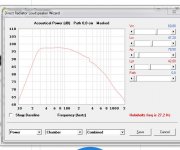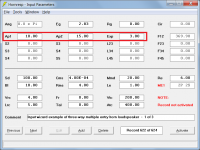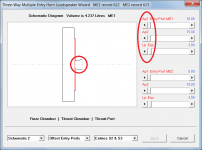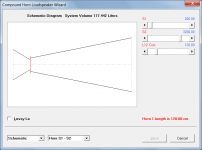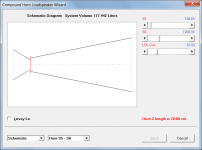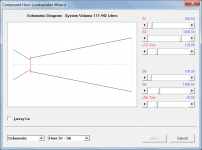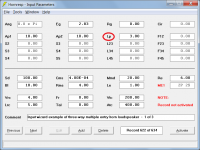Als the length is 45 cm
Could the long port tube perhaps be replaced with a passive radiator?
Could the long port tube perhaps be replaced with a passive radiator?
No that is not possible because of bracing, I have a downfiring closed box 64 liters, when I do simulate with a bassreflex I get fairly low, maybe the speaker is a good fit with low vas and high Sd, calculations say it is better for closed, the speaker is 12 inch.
I can split the tubes then I do need two 6 cm ones, get some more cm2 but it is more suitable because of ethic view she come out on the sides, if it is aloowed that the input of the tubes are quite close to the speaker in the box, because then, it needs to output just above the floor.
I see a small resonance tube, but the sub goes not so high, it stops around 100 hz.
regards
Attachments
Last edited:
Didn't your Mommy teach you to not play on the road? And in France even!
Back from France... Tried to teach the kids not to play on the road, but since all the french kids were out on the streets skating and biking - I had no chance to do correct parenting - history repeats itself.. bought some city scooters for myself and joined the madness
You are welcome, glad I could help.Hi Sabbelbacke,
Thanks for checking. It would seem that the problem is definitely at my end, not yours.
@all having "issues" with virus-scans:
This is "normal".. Since many viruses disguise them self by mutating, Scanners to some "heuristic-scans", where they try to detect possible threads by looking for suspicious patterns in the files... This way they have a chance to catch viruses even if they are not known to the virus-scanner via a definitive signature.
It´s in the nature of this procedure not to be perfect and sometimes give false alarms. The principle is: "Better to have a false alarm once in a while than to loosen security and let a tricky virus/trojan/etc... slip through into your PC"....
Back from France... Tried to teach the kids not to play on the road, but since all the french kids were out on the streets skating and biking - I had no chance to do correct parenting - history repeats itself.. bought some city scooters for myself and joined the madness
Hope you had a pleasant time with the children.
Following on from my earlier comments:
I checked to confirm that Hornresp was calculating the phase results as intended, but on further discussion with bolserst via email it became apparent that the Help file description of the phase response chart was ambiguous in that it did not make it clear that the distance between the sources was excluded from combined response phase calculations. This was essentially the reason for the misunderstanding that led to the original confusion. The Help file description will be changed in the next release to hopefully remove this ambiguity.
The combined phase is calculated to be zero degrees when sides 1 and 2 are identical because the two signals are exactly 180 degrees apart at all frequencies, and when summed vectorially the resultant phase becomes zero.
I need to investigate (1) further.
I checked to confirm that Hornresp was calculating the phase results as intended, but on further discussion with bolserst via email it became apparent that the Help file description of the phase response chart was ambiguous in that it did not make it clear that the distance between the sources was excluded from combined response phase calculations. This was essentially the reason for the misunderstanding that led to the original confusion. The Help file description will be changed in the next release to hopefully remove this ambiguity.
The current model automatically calculates zero phase when sides 1 and 2 are identical
The combined phase is calculated to be zero degrees when sides 1 and 2 are identical because the two signals are exactly 180 degrees apart at all frequencies, and when summed vectorially the resultant phase becomes zero.
Last edited:
bought some city scooters for myself and joined the madness
"When in Rome, do as the Romans do".
(But in your case in France, rather than Italy)
Hey Mark and David,
yes, it was very nice, thank you Whenever I visit foreign countries I try to blend in with "the locals" - much more fun than doing the usual tourist routine (and much cheaper most of the times - if you eat/drink where the locals are going, you don´t get the ripp-off prices tourists get... And you are forced to brush up your language skills, which always is good for a lough on both sides..)
Whenever I visit foreign countries I try to blend in with "the locals" - much more fun than doing the usual tourist routine (and much cheaper most of the times - if you eat/drink where the locals are going, you don´t get the ripp-off prices tourists get... And you are forced to brush up your language skills, which always is good for a lough on both sides..)
yes, it was very nice, thank you
Hornresp Update 5050-191010
Hi Everyone,
CHANGE 1
The offset entry ports in a multiple entry horn loudspeaker system can now have a conical, exponential or parabolic flare profile, as shown in Attachments 1 and 2.
CHANGE 2
Previously, when horn 1 in a compound horn system had one segment, the sliders for horns 1 and 2 were displayed separately, as shown in Attachments 3 and 4. They are now displayed together, as shown in Attachment 5.
CHANGE 3
The following clarifying information has been added to the phase response section of the Help file:
"The combined phase response is the vector sum of the phases of the two outputs. The distance between the outputs is not taken into account."
Kind regards,
David
Hi Everyone,
CHANGE 1
The offset entry ports in a multiple entry horn loudspeaker system can now have a conical, exponential or parabolic flare profile, as shown in Attachments 1 and 2.
CHANGE 2
Previously, when horn 1 in a compound horn system had one segment, the sliders for horns 1 and 2 were displayed separately, as shown in Attachments 3 and 4. They are now displayed together, as shown in Attachment 5.
CHANGE 3
The following clarifying information has been added to the phase response section of the Help file:
"The combined phase response is the vector sum of the phases of the two outputs. The distance between the outputs is not taken into account."
Kind regards,
David
Attachments
Well another bit of awesomeness! This program keeps getting better. A great blend of accessibility and functionality.
I'm in China working for a few weeks and I will be both using and showing this program with a few knowledgeable gents. It always amazes them to see what this little program can do.
I have a concentric two way horn to design. I wonder what I will be using????


I'm in China working for a few weeks and I will be both using and showing this program with a few knowledgeable gents. It always amazes them to see what this little program can do.
I have a concentric two way horn to design. I wonder what I will be using????
in BP4 and BP6 Loudspeaker Wizard, are both chambers and port(s) sliders on the same screen like your CH update?
Hi BP1Fanatic,
No - to avoid cluttering up the form, the maximum number of sliders permitted per screen is seven.
BP4
Chamber 1 = 5 sliders
Chamber 2 = 3 sliders
Total = 8 sliders
BP6
Chamber 1 = 5 sliders
Chamber 2 = 5 sliders
Total = 10 sliders
CH update total = 6 sliders
Kind regards,
David
Hi,
Due to those new change, at first i was affraid, but in fact, in ME1 ME2 screen (when using multi-entry wizard), for a previous done design, to make things equivalent to previous result in previous version, we just have to set L12 to CON segment, and put in it field Ap2 value, and so set Ap2 value to Ap1 value.
Not sure many can understand what this sentence is about. ^^
Due to those new change, at first i was affraid, but in fact, in ME1 ME2 screen (when using multi-entry wizard), for a previous done design, to make things equivalent to previous result in previous version, we just have to set L12 to CON segment, and put in it field Ap2 value, and so set Ap2 value to Ap1 value.
Not sure many can understand what this sentence is about. ^^
Last edited:
we just have to set L12 to CON segment, and put in it field Ap2 value, and so set Ap2 value to Ap1 value.
Hi Damien,
To specify a cylindrical port all that is really required is that Ap2 = Ap1, so that the mouth area equals the throat area. For the port tube length Lp, it doesn't really matter what flare profile is specified - it can be Con, Exp or Par, or even just left as Lp, as shown in the attachment. If left as Lp, and Ap1 is not equal to Ap2, then the flare will be conical by default.
Kind regards,
David
Attachments
Feature Request - Acoustic Impedance Plots
Hello David,
Please excuse my newbie ignorance but I understand that the acoustic loading is resistive in horns, reactive in transmission lines and capacitative in bass reflex and sealed enclosure designs. While designing tapered TLs or MLTLs, as the taper or mass load increases, I slowly slip into the bass reflex domain.
Right now, I can see resistance and reactance plots under acoustic impedance. Is it possible to split reactance data and plot capacitance and inductance separately in Hornresp?
Hello David,
Please excuse my newbie ignorance but I understand that the acoustic loading is resistive in horns, reactive in transmission lines and capacitative in bass reflex and sealed enclosure designs. While designing tapered TLs or MLTLs, as the taper or mass load increases, I slowly slip into the bass reflex domain.
Right now, I can see resistance and reactance plots under acoustic impedance. Is it possible to split reactance data and plot capacitance and inductance separately in Hornresp?
Feature Request - Acoustic Impedance Plots
Hello David,
Please excuse my newbie ignorance but I understand that the acoustic loading is resistive in horns, inductive in transmission lines, and capacitative in bass reflex and sealed enclosure designs. While designing tapered TLs or MLTLs, as the taper or mass load increases, I slowly slip into the bass reflex domain.
Right now, I can see resistance and reactance plots under acoustic impedance. Is it possible to split reactance data and plot capacitance and inductance in Hornresp?
Hello David,
Please excuse my newbie ignorance but I understand that the acoustic loading is resistive in horns, inductive in transmission lines, and capacitative in bass reflex and sealed enclosure designs. While designing tapered TLs or MLTLs, as the taper or mass load increases, I slowly slip into the bass reflex domain.
Right now, I can see resistance and reactance plots under acoustic impedance. Is it possible to split reactance data and plot capacitance and inductance in Hornresp?
Last edited:
Is it possible to split reactance data and plot capacitance and inductance in Hornresp?
Hi Giri,
Hornresp calculates the acoustical impedance at a given surface as the complex ratio of effective sound pressure averaged over the surface, to the effective volume velocity through it. The reactive component of the impedance is not calculated in terms of capacitive and inductive elements.
Kind regards,
David
- Home
- Loudspeakers
- Subwoofers
- Hornresp
